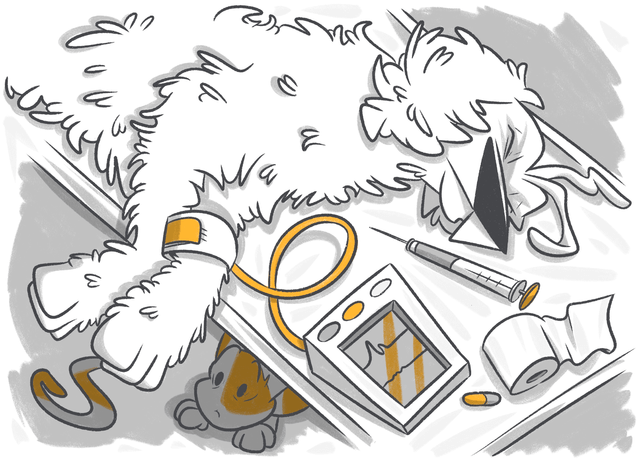One of the toughest parts of dog ownership is when they start to fade away in their golden years. And for senior dog owners, a common cause is congestive heart disease or congestive heart failure (CHF). It's so common that veterinarian sources suggest that up to 10% of dogs and about 75% of senior dogs have some kind of heart disease.
There are many kinds of heart disease, with PDSA research showing that mitral valve disease is extremely common in small breeds, especially the Cavalier King Charles Spaniel, where it can affect about 90% of them. In large breeds, studies show that dilated cardiomyopathy is extremely common, and it's often linked to deficiencies in taurine or L-carnitine. When heart disease progresses so far, the heart runs out of fuel, and it becomes congestive heart failure in dogs.
Stop Googling - Ask a Real Vet
Content:
- Signs and Symptoms of Congestive Heart Failure in Dogs
- What Causes Congestive Heart Failure In Dogs
- Stages Of Congestive Heart Failure In Dogs
- Treatment for Congestive Heart Failure in Dogs
- How Can The Emergency Fund Help With Treatment
- FAQs
- Conclusion
Signs and Symptoms of Congestive Heart Failure In Dogs
Let's start by understanding what congestive heart failure (CHF) is, in simple words. It's a condition where the heart isn't pumping blood as well as it should. This means that the body isn't getting enough oxygen and nutrients, which it needs to function properly.
Heart disease is a silent killer, and we often don't see the symptoms until it becomes heart failure, at which point it can be too late. So it's vital to pick up on the signs of congestive heart failure in dogs early.
A friend of mine's 10-year-old Anatolian Shepherd recently began to lose weight. He started losing interest in food several months ago. His owner thought it was the right kind of food and switched the food several times to entice Pip to eat.
Pip lost weight rapidly, with his backbones, hips, and rib bones starting to protrude. He was often restless at night. Soon his gums turned pale with a bluish tinge, and then he began to cough when he lay down. The vet diagnosed him with CHF, and his symptoms are all pretty typical of the condition.
Now, let's decode the signs Pip was showing so that you can catch them in your dog. Remember, the earlier you intervene with CHF, the better chance your dog has.
- Loss of appetite and weight loss: One of the first signs of CHF is when people stop eating as much as before. Their weight starts dropping fast, too, with bones becoming more visible. This happens because the body tries to use up its energy reserves since it isn't getting enough from food.
- Restlessness: Dogs with heart failure are often restless, especially at night. This can happen because fluid can build up in the lungs due to the heart not pumping properly. This can make it hard for them to get comfortable and sleep.
- Pale and bluish gums: Pale or bluish gums can indicate that the body isn't getting enough oxygen, a common problem when a dog has CHF. You see, the heart isn't pumping blood well, which means oxygen isn't effectively reaching all parts of his body.
- Coughing (especially when lying down): This is a classic sign of CHF in dogs. When the dog lies down, fluid can build up in his lungs, causing him to cough. This fluid buildup directly results from the heart not pumping blood efficiently.
- Ascites: This is a fancy term for fluid buildup in the belly. Ascites happen because when a dog's heart can't pump blood effectively, the blood can back up into the liver and cause fluid to leak out into the belly. This could make the belly look bloated or swollen. This fluid buildup presses on the lungs and is another reason a dog starts to cough, especially when lying down.
- Reduced stamina: Another common early sign is that a dog is tiring quickly during walks or doesn't play as much as they used to. It's easy to miss this in older dogs, especially when they have arthritis and are already less mobile. This decreased stamina can happen because his body isn't getting enough oxygen and nutrients from the blood, so his muscles tire out more quickly.
- Muscle waste: This is another reason that dogs with heart failure start to lose weight. As they're not eating much and their body isn't getting enough nutrients from the blood, their body might be breaking down muscle tissue for energy. This can lead to muscle loss or waste.
Remember, these symptoms can also be signs of other health problems, so getting any changes in behavior or physical appearance checked out by a vet is essential. In Pip's case, the vet was able to diagnose him with CHF based on these symptoms and likely some additional tests.
Keeping an eye on a senior dog at all times is vital to monitoring their condition and changes in behavior. We suggest using a Pet Camera to check on them periodically when you need to leave the house.
While CHF is a serious condition, it's not a death sentence. Some treatments can help manage it and help dogs like Pip live a more comfortable life.
What Causes Congestive Heart Failure in Dogs

Many different heart conditions can cause congestive heart failure in dogs. These are the main ones:
- Mitral Valve Insufficiency (MVI): This is the most common cause of CHF in dogs, accounting for about 80% of cases. The mitral valve sits between the two left chambers of the heart. A healthy heart, it ensures that blood flows in the right direction.
But in MVI, this valve leaks, allowing some blood to flow backward. This puts extra strain on the heart and, over time, can lead to left-sided CHF. If left untreated, heart failure can progress to affect both sides of the heart. Though MVI can be present from birth, it's usually something we see develop as dogs get into their middle or senior years, much like our friend Pip.
-
Dilated Cardiomyopathy (DCM): DCM is another cause of CHF. In this case, the heart becomes enlarged because its muscle walls stretch and become thin. This means the heart can't pump blood as effectively. Over time, this can lead to CHF. Certain breeds are predisposed to this condition, but it can occur in any dog.
-
Atrial Septal Defect: This is essentially a hole in the wall (septum) between the two upper chambers (atria) of the heart. This defect allows blood to flow from one atrium to the other, which can lead to CHF if it's severe enough.
-
Patent Ductus Arteriosus (PDA): This is a condition that should naturally correct itself shortly after a puppy is born. In a developing fetus, the ductus arteriosus is a blood vessel that allows blood to bypass the lungs, which aren't yet in use. After birth, this should close off. If it doesn't, it can cause blood to flow in the wrong direction, from the aorta into the pulmonary artery, which can eventually lead to CHF.
It's important to note that these causes can sometimes overlap, and one heart condition can sometimes lead to another.
Left-sided Congestive Heart Failure vs. Right-sided Congestive Heart Failure
When we talk about left-sided or right-sided congestive heart failure (CHF), we're referring to which part of the heart isn't working correctly.
Left-sided CHF: This is often the result of conditions like mitral valve insufficiency, where the valve on the left side of the heart isn't working correctly. In left-sided CHF, the left side of the heart can't effectively pump blood out to the body. As a result, blood backs up in the lungs since it can't move forward as it should.
This can lead to fluid accumulation in the lungs, known as pulmonary edema. Symptoms related to this type of heart failure often include coughing, breathing difficulties, and fatigue, especially during exercise.
Right-sided CHF: This happens when the right side of the heart can't pump blood effectively to the lungs. Instead of blood flowing to the lungs to pick up oxygen, it starts to back up in the body. This can lead to fluid buildup in the abdomen (ascites) and swelling in the legs.
Signs of right-sided heart failure can include a swollen belly, weight gain from fluid retention, and, less commonly, swelling in the legs.
It's worth mentioning that while left-sided and right-sided CHF have different initial symptoms, one can lead to the other if not managed properly. For instance, if left-sided CHF isn't treated, it can put so much strain on the heart that the right side starts to fail as well, and vice versa.
Biventricular heart failure, as the name suggests, is when both the left and right sides of the heart (hence 'bi-, meaning 'two') are not working efficiently. Essentially, this is a condition where both left-sided and right-sided congestive heart failure are happening at the same time.
Stages Of Congestive Heart Failure in Dogs
It's important to know that the progression of heart disease and heart failure in dogs is often categorized using a system developed by the American College of Veterinary Internal Medicine (ACVIM). This system classifies heart disease and heart failure into four stages: A, B, C, and D.
-
Stage A: This is the earliest stage where the dog is at high risk for developing heart disease but does not yet have any identifiable heart disease or symptoms. This includes dogs with a genetic predisposition to conditions like mitral valve disease or dilated cardiomyopathy.
-
Stage B: At this stage, heart disease is present, but there are still no visible signs of heart failure. This stage is further divided into two parts: Stage B1, where heart disease is evident (for example, a heart murmur can be heard or changes are seen in an echocardiogram) but the heart is not yet enlarged, and Stage B2, where the heart is enlarged due to heart disease but the dog is not showing any symptoms.
-
Stage C: This stage is when heart disease has progressed to symptomatic heart failure. Dogs in Stage C are showing clinical signs of heart failure that can be linked directly to their heart disease. This is typically the stage where symptoms like coughing, difficulty breathing, decreased exercise tolerance, or even fainting occur. These symptoms often become evident during a physical exam or on diagnostic tests like X-rays, EKGs, or echocardiograms.
-
Stage D: This is the most severe stage of heart failure, where the dog is still showing symptoms despite receiving treatment. Stage D requires advanced and aggressive treatment to manage.
Remember, these stages are not necessarily linear; they are more like a guide to understanding the progression of heart disease into heart failure. Depending on many factors, a dog might move quickly through some stages and slower through others.
Identifying the stage of heart failure that a dog is in helps veterinarians plan the most effective treatment.
Treatment for Congestive Heart Failure in Dogs

Your veterinarian will outline the best course of treatment when your dog has CHF. It is vital not to rely on home remedies. However, Dr. Linda Case, DVM, and Dr. Dorothy P. Laflamme, DVM, do outline some dietary guidelines that can help give a dog with CHF a fighting chance.
-
Medical Treatment: The management of CHF in dogs often involves the use of medications. These can include drugs that help the heart pump more efficiently, reduce fluid accumulation in the body, and manage any accompanying symptoms. Medications such as diuretics, ACE inhibitors, and beta-blockers are commonly prescribed. Always adhere to the instructions provided by your veterinarian when giving these medications to your dog.
-
Dietary Changes: A specially tailored diet plays a crucial role in managing CHF. This diet usually includes:
- Low-sodium: A diet low in sodium is beneficial in preventing fluid retention and lessening the burden on the dog's heart.
- High-quality Protein: Including good-quality protein in the diet helps to maintain muscle mass and overall health.
- Antioxidants: Incorporating antioxidants such as vitamin E into the diet can help mitigate oxidative stress that could further compromise the heart.
- Supplements: Depending on the specific condition of your dog, it might be beneficial to supplement the diet with taurine or L-carnitine, which are vital for heart health.
- Purified MCT Oil: Medium-chain triglyceride (MCT) oil (extracted from coconut or palm oil) helps the liver manufacture ketones, which the heart muscle can use as a much-needed source of extra fuel.
- Omega-3 Fatty Acids: These fatty acids that you can get from fresh oily fish or green-lipped mussel extract are vital for heart function (especially DHA). Try to get them directly from reliable marine sources.
It's crucial to strike a balance by providing a diet that is both nutritious and appetizing to ensure that the dog is encouraged to eat. Weight maintenance or even weight gain is critical, as studies have shown improved outcomes in dogs with CHF who can maintain or increase their weight.
- Lifestyle Changes: Engaging your dog in moderate exercise can help to keep their muscles strong and maintain a healthy weight. It's crucial, however, not to overexert the dog. The exercise regime should be customized to the dog's condition and individual capabilities.
In summary, while CHF is a severe condition, it can be effectively managed. By collaborating closely with your veterinarian and implementing necessary dietary and lifestyle changes, a dog with CHF can still enjoy a good quality of life.
How Can The Emergency Fund Help With Treatment
Facing an emergency vet bill can be daunting, but with the Petube Emergency Fund, help is available. For just $1 a day, you can receive up to $3000 to cover emergency vet bills. Plus, this fund provides 24/7 online veterinary telehealth access, offering timely advice when you need it the most and ensuring your pet gets the best care possible in a crisis.
FAQs
What does it sound like when a dog with congestive heart failure coughs?
A dog with congestive heart failure often has a persistent, dry, hacking cough that can become more severe when lying down or just after being active.
How long can a dog with congestive heart failure live?
With proper treatment and management, a dog with congestive heart failure can live for several years. However, each case is unique, and life expectancy varies based on the severity and progression of the disease.
Conclusion
Congestive heart failure in dogs is a serious but manageable condition. With proper treatment, dietary changes, and lifestyle adaptations, dogs can maintain a good quality of life. Early detection and ongoing veterinary care are key to managing this condition effectively.
Remember, your canine companion depends on you for their heart health, so always be aware of the signs and consult your vet if you notice any changes.
Was this article helpful?
Help us make our articles even better









